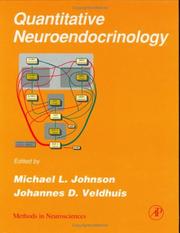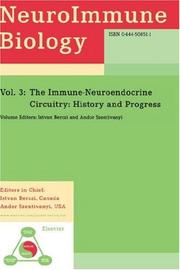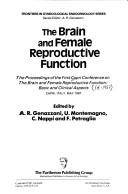| Listing 1 - 10 of 99 | << page >> |
Sort by
|

ISBN: 9780121852986 0121852989 9780080536477 0080536476 1281046345 9781281046345 9786611046347 Year: 1995 Publisher: San Diego : Academic Press,
Abstract | Keywords | Export | Availability | Bookmark
 Loading...
Loading...Choose an application
- Reference Manager
- EndNote
- RefWorks (Direct export to RefWorks)
In this volume contemporary methods designed to provide insights into, mathematical structure for, and predictive inferences about neuroendocrine control mechanisms are presented.Key Features* Collates an array of contemporary techniques for analysis of neuroendocrine data* Discusses current problems in and solutions to neurohormone pulse analysis* Identifies relevant software available
Periodical
ISSN: 14230194 Year: 1966 Publisher: [Basel, Switzerland] : Karger
Abstract | Keywords | Export | Availability | Bookmark
 Loading...
Loading...Choose an application
- Reference Manager
- EndNote
- RefWorks (Direct export to RefWorks)
Neuroendocrinology --- Neuroendocrinologie --- Neuroendocrinology. --- Endocrinology --- Neurology --- Neurohormones --- Neuroendocrinologie.
Book
ISBN: 128058257X 9786613612359 0123785545 0123750970 Year: 2012 Publisher: Amsterdam ; Boston : Academic Press/Elsevier,
Abstract | Keywords | Export | Availability | Bookmark
 Loading...
Loading...Choose an application
- Reference Manager
- EndNote
- RefWorks (Direct export to RefWorks)
Neuroendocrinology, the discipline concerned with how the nervous system controls hormonal secretion and how hormones control the brain, is pivotal to physiology and medicine. Neuroendocrinology has disclosed and underpins fundamental physiological, molecular biological and genetic principles such as the regulation of gene transcription and translation, the mechanisms of chemical neurotransmission and intracellular and systemic feedback control systems. Reproduction, growth, stress, aggression, metabolism, birth, feeding and drinking and blood pressure are some of the bodily functions that
Neuroendocrinology. --- Endocrinology --- Neurology --- Neurohormones

ISBN: 9780444508515 0444508511 9781435605411 1435605411 0080542514 9780080542515 1281054690 9781281054692 9786611054694 6611054693 Year: 2003 Publisher: Amsterdam ; Boston : Elsevier,
Abstract | Keywords | Export | Availability | Bookmark
 Loading...
Loading...Choose an application
- Reference Manager
- EndNote
- RefWorks (Direct export to RefWorks)
The book summarises the current understanding of the Nervous -, Endocrine and Immune systems with emphasis on shared mediators and receptors and functional interaction. In addition to the fundamental physiological and pathophysiological mechanisms, which are presented in detail, some clinically relevant subjects are also presented, such as inflammation, asthma and allergy, autoimmune disease, immunodeficiency and the acute phase response. A comprehensive presentation of neuroimmune biology Introduces the subject matter to the uninformed reader Contains basic informatio

ISBN: 0080553311 9780080553313 9780444518224 0444518223 0444518231 9780444511737 0444511733 9780444518231 128105979X 9786611059798 Year: 2005 Publisher: Amsterdam ; London : Elsevier,
Abstract | Keywords | Export | Availability | Bookmark
 Loading...
Loading...Choose an application
- Reference Manager
- EndNote
- RefWorks (Direct export to RefWorks)
The Handbook of Stress and the Brain focuses on the impact of stressful events on the functioning of the central nervous system; how stress affects molecular and cellular processes in the brain, and in turn, how these brain processes determine our perception of and reactivity to, stressful challenges - acutely and in the long-run. Written for a broad scientific audience, the Handbook comprehensively reviews key principles and facts to provide a clear overview of the interdisciplinary field of stress. The work aims to bring together the disciplines of neurobiology, physiology, immuno

ISBN: 9789004628021 9789004095618 9004628029 Year: 1994 Publisher: Leiden ; Boston : Brill,
Abstract | Keywords | Export | Availability | Bookmark
 Loading...
Loading...Choose an application
- Reference Manager
- EndNote
- RefWorks (Direct export to RefWorks)
Part VI of Keys to the Insects of the European Part of the USSR covers the suborder Symphyta of the phytophagous Hymenoptera (sawflies and woodwasps), small superfamilies Trigonaloidea, Stephanoidea, Evanioidea of parasitic Apocrita, and the family Paxilommatidae of the superfamily Ichneumonoidea. Identification keys are provided for 18 families, 123 genera and over 900 species which include a large number of economically important species — the pests of agricultural crops and timber as well as entomophages. A brief outline of morphology and biology, synonymy and geographic distribution is given for each family and genus and the known host-plants are indicated for every species. Three species have been described for the first time and 12 new subgenera have been separated. Bibliography — 88 citations; 217 illustrations.
Book
ISBN: 3036557644 3036557636 Year: 2023 Publisher: [Place of publication not identified] : MDPI - Multidisciplinary Digital Publishing Institute,
Abstract | Keywords | Export | Availability | Bookmark
 Loading...
Loading...Choose an application
- Reference Manager
- EndNote
- RefWorks (Direct export to RefWorks)
Endocrine and neuroendocrine tumors originate from endocrine cells but are heterogeneous in terms of clinical presentation, disease outcome, and treatments available. This Special Issue addresses specific aspects of pre-clinical, clinical, and translational research and clinical management of these diseases with the aim of providing novel insights, addressing current unmet needs, and discussing future treatment perspectives.
Neuroendocrine tumors. --- Neuroendocrinology. --- Endocrinology --- Neurology --- Neurohormones --- Tumors

ISBN: 9780120884841 0120884844 9780080498164 0080498167 1281010790 9786611010799 Year: 2006 Publisher: Amsterdam ; Boston : Elsevier Academic Press,
Abstract | Keywords | Export | Availability | Bookmark
 Loading...
Loading...Choose an application
- Reference Manager
- EndNote
- RefWorks (Direct export to RefWorks)
The somatotropic axis is one of the major hormonal systems regulating postnatal growth in mammals. It interacts with the central nervous system on several levels. Growth hormone (GH) and insulin-like growth factor-I (IGF-I) receptors are expressed in many brain areas including the hippocampus, pituitary and hypothalamus. GH and IGF-I are important factors in the development and differentiation of the CNS and have protective properties in dementia, as well as in traumatic and ischaemic injury of the CNS. Also GH has an important impact on mood and well-being with GH secretory capacity being red
Growth hormone releasing factor. --- Neuroendocrinology. --- Somatotropin.

ISBN: 0940813092 Year: 1988 Publisher: Carnforth Parthenon
Abstract | Keywords | Export | Availability | Bookmark
 Loading...
Loading...Choose an application
- Reference Manager
- EndNote
- RefWorks (Direct export to RefWorks)
Endocrine gynecology --- Human reproduction --- Neuroendocrinology --- Congresses
Book
Abstract | Keywords | Export | Availability | Bookmark
 Loading...
Loading...Choose an application
- Reference Manager
- EndNote
- RefWorks (Direct export to RefWorks)
Neurochemistry --- Neuroendocrinology --- Vagotomy --- Vagus nerve --- Congresses --- Complications
| Listing 1 - 10 of 99 | << page >> |
Sort by
|

 Search
Search Feedback
Feedback About UniCat
About UniCat  Help
Help News
News